How to paint a gas stove at home: subtleties of choosing paint + painting instructions
Many owners of old household appliances wonder from time to time whether it is possible to give the device a second life. Over time, the old surface becomes unusable for various reasons, the paint begins to crack and peel, moisture gets into the cracks, after which the iron rusts. Why not restore functional equipment, don’t you agree? But how to do this and what materials may be needed?
In this article we will talk about how to paint a gas stove at home and what paint is suitable for this purpose. We will also tell you how to prepare the surface for applying paint and what is the best way to restore the grille.
The content of the article:
Features of surface and enamel for painting
To paint the surface of a slab, you do not need to have special knowledge; it is enough to have basic information and take into account some features when painting yourself. But it is worth considering the fact that ordinary enamel is not suitable for painting the surface of a gas stove, since when exposed to high temperatures, such paint very quickly deteriorates and peels off.
You can paint the slab at the place where it is installed, but it is still advisable temporarily turn off the device from the gas supply network.
First, let's look at the type of surface of gas stoves.So, most often, in the manufacture of gas appliances, they use alloy stainless steel. The metal has a high degree of resistance to high temperatures.
This surface is painted with special enamel to protect the coating from corrosion and give the gas appliance a beautiful appearance.
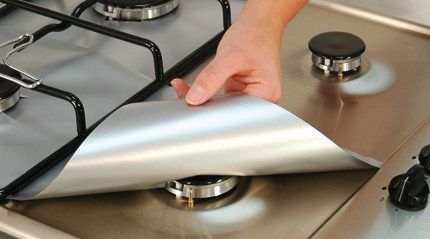
Plain enamel or acrylic paint is not suitable for painting the surface of a gas stove. Because when exposed to high temperatures, it will melt and burn.
The paint for the surface of a gas stove must be resistant to high temperatures and other destructive factors.
As a rule, enamels with the following properties are used for painting:
- Internal stability. Such enamels withstand high temperatures well and do not deteriorate in conditions of high acidity.
- External stability. This protection is designed to protect the metal surface; the enamel protects both from thermal stress and chemical processes.
Such characteristics are necessary for long-term use of a gas appliance in aggressive conditions.
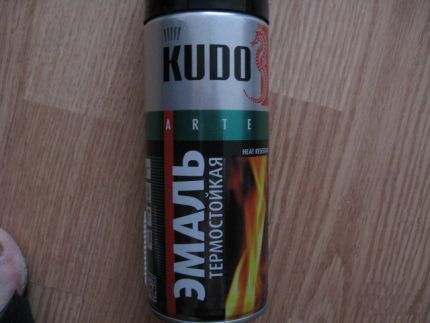
To achieve the required level of stability, enamel for restoration of a gas stove must include the following elements:
- quartz sand;
- soda;
- feldspar;
- borax.
All these elements form a transparent mixture, to which you need to add some more components.
To obtain the most effective paint for devices exposed to high temperatures, the following elements are additionally added during production:
- alumina;
- zinc;
- alkaline elements;
- titanium;
- lead.
This entire composition forms a high-quality paint with high resistance to aggressive factors and imparts a beautiful shine to the painted surface.
It is worth noting that enamels with the addition of cobalt and nickel oxides have better adhesion to the element being painted. This paint can be applied even to a surface that has not been treated with a primer.
Positive and negative properties of enamel
Before you begin restoration work, you need to find out all the positive and negative aspects of the enamel coating.
Let's look at the pros and cons of the enameled surface of a gas stove:
- high degree of resistance to high temperatures;
- variety of colors;
- reasonable cost of paint;
- protection from various contaminants.
All these advantages allow you to confidently use this type of coating for a gas stove.
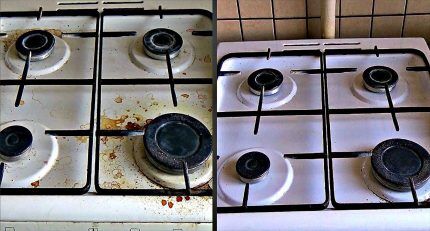
But, despite all the positive qualities of the material, it is worth paying attention to the disadvantages.
Among them, the most significant are the following:
- Problems often arise with cleaning the surface from carbon deposits.
- Weak resistance to mechanical stress - the material is very fragile, so there is a high probability of chips on the surface.
In general, this coating is very reliable and retains its color saturation and original shine for a long time.
Selection of paint and application methods
During the operation of the stove, minor damage, scratches, cracks form on the surface, where grease, dust, accidentally spilled soup or coffee become clogged. Thus, the metal surface is unprotected and can quickly deteriorate.
If the coating of your gas stove has become unusable, do not be upset and think about buying a new stove. If you paint it immediately, it will look like new.
First of all, you need to pay attention to the choice of paint, which must correspond to the operating conditions. So, the material must withstand high temperatures, so you need to use heat-resistant paint. Therefore, when choosing, pay attention to heat resistant paint - it can withstand high temperatures, up to 1000 degrees. This will be quite enough for a gas stove.
Painting the surface of an old gas stove can be done by applying heat-resistant paint with a brush or spray. The second method of applying paint is the most effective. You can also use a can of heat-resistant material.
To effectively apply a layer of paint to the surface of a gas stove, it is best to use spraying method. To do this, you can use a spray bottle, but it is more rational to buy paint in cans, since the area to be painted is not so large.
Using the spraying method, you can significantly reduce paint consumption and apply a layer evenly - this will be more reliable and more beautiful.
Procedure for painting
To repaint a slab efficiently, you need to have some knowledge and follow the instructions. Violation of the technological process can lead to poor results after completion of the work.
Stage #1 - preparation of materials
If you decide to paint a gas stove with your own hands, then you will need the following materials and tools: surface degreasing liquid, heat-resistant paint, a utility knife or scissors, masking tape.
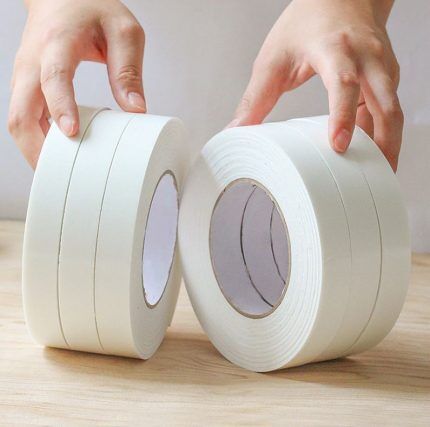
Stage #2 - surface cleaning and preparation
Before you begin restoring the surface, you need to inspect it thoroughly. If there are deep chips and cracks on the gas stove, then it is recommended to remove the entire layer of old paint and thoroughly clean the entire surface. If the paint is not damaged, then it is enough to degrease the coating for further painting.
To remove old paint, you can use a metal brush or a metal-bristled drill attachment.
You can also use special chemicals to remove old paint, but this is ineffective and expensive. It is best to remove old paint outdoors, as small dust particles will fly around the room and settle on furniture and other surfaces.

When the paint layer is cleaned, preparatory work should be carried out:
- Any surface must be degreased and remove all dirt and stains to achieve maximum adhesion of the paint to the surface of the slab. If this is not done, then a new layer may peel off in places of contamination and the process of destruction of the metal base of the equipment may begin.
- Gas burners must be closed before you start applying paint. This way the paint will not get into the nozzle holes, otherwise the jets will have to be changed or clean. You also need to cover furniture and other elements with paper or polyethylene so as not to stain them during work.
- You can use masking tape to create clear outlines. after painting the surface, if you are going to carry out the restoration in two colors.
When surface preparation is complete, you need Shake the paint can thoroughly. This must be done before you begin painting the gas stove. This will allow you to achieve uniform application of paint and increase the efficiency of its distribution.

Stage #3 - spray paint application
Below are detailed instructions, following which you can paint the old gas appliance with the highest quality possible.
Work order:
- Ensure good ventilation of the room. It is worth understanding that the paint contains chemicals that can harm your body. Therefore, it is necessary to paint a gas stove in a well-ventilated area or in the open air. Otherwise, you may get poisoned or have more serious health problems.
- Apply the first coat of paint. When spraying paint, the can must be kept at a distance of about 20 centimeters from the coating, but when applying several colors, the distance must be reduced to 10 centimeters, near the color border. This is necessary to achieve the most even contour and increased color saturation.
- Apply a second coat of paint after 5 minutes. As soon as the first coat of paint has been applied, after 5 minutes you should begin applying a second coat. This will help prevent old stains from appearing and will also give the surface a richer color. In addition, additional application of paint increases all protective properties, including heat resistance.
By following these algorithms, you will be able to restore your gas stove yourself. This way, your appliance will retain its beautiful appearance, and you will not need to spend a lot of money on the purchase of expensive gas equipment.
By the way, after painting the slab, you can also update gas pipe, painting it with fresh paint.
Stage #4 - painting the gas grill
In order for the restoration of the stove to be complete, we will figure out how to paint the grate of a household gas stove. After all, the equipment cannot do without updating this element.
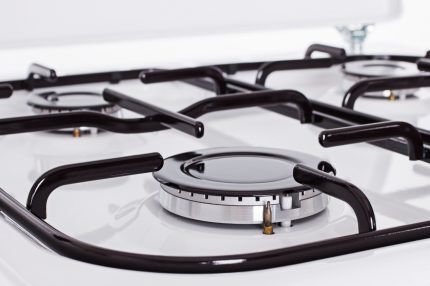
You can paint the grille using the same heat-resistant paint. But, as a rule, they are not painted. Typically, gratings are made of cast iron, and this metal has a high degree of resistance to aggressive factors. Therefore, it is enough to simply remove carbon deposits mechanically or using a gas burner.
In another article on our website, we looked at the best ways to deal with grate contaminationmade from various materials.
Conclusions and useful video on the topic
Next, watch a video about the properties of heat-resistant paint in cans:
The process of surface restoration is not a difficult task, but it still requires some effort and expense. If you do everything according to technology, you can achieve good results. This will improve the performance properties of the working surface of the gas stove. And also give it a beautiful appearance, thereby saving money on the purchase of new equipment.
But independent restoration may not always bring the expected result. Therefore, if you are not sure that you can cope with such a task, then it’s time to turn to professionals who know their business and can get the job done quickly and efficiently.
Have you recently painted an old stove yourself? Share a photo of the finished work in the comments section, tell us what paint you purchased for these purposes.Write your recommendations, participate in discussions on the feasibility of painting a surface, answer questions from other users if you have already encountered a similar question.




